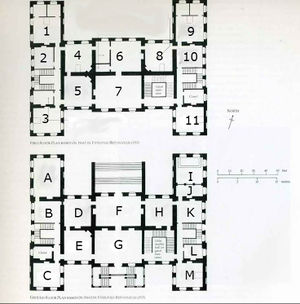Ashbray House

Ashbray House is the Leicestershire residence of Mr. Barnaby Palmer, Lady Francesca Palmer, Miss Jemima Palmer, and Miss Cecily Palmer. It was constructed between 1685 and 1688 by Samuel Horlock, 3rd Baron Horlock, in the Carolean style. The house remained in the family until the death of the 5th Baron in 1758, when the Baron's impoverished son-in-law sold it to Mr. Robert Palmer, father of Barnaby.
The house's grounds are extensive, with a 1000-acre park, first enclosed in 1690. The outbuildings include a stable block, an orangery, and a small church. There are several gardens and a handful of follies, though these are not nearly as prevalent at Ashbray House as they are at nearby Raulings Park.
Ashbray House is portrayed by Belton House.
Interior

The plan of the house may be seen at left. It was designed with the intention that the center part of the house would be public, while the rooms at the extremities were for the use of the family. Upon coming through the main entrance, visitors find themselves in the main doors (G), with the formal drawing room (F) directly ahead. To the left are the tapestry room (E) and the music room (C) (previously the schoolroom). To the right are the little hall, containing the great staircase, and the blue bedroom (M) (previously Miss Cecily's room, until her sister went to France in 1807), with the attached dressing room (L). To the left of the formal drawing room are the red drawing room (D), commonly used by the family, the breakfast room (B), and the kitchen (A), which is actually a two-story room beginning on the lower level - the high ceiling allows the heat to escape. This structure is mirrored in the chapel (I), with its raised gallery for the family and other distinguished worshipers (J). The ground floor is completed by the chapel drawing room (K) and the smoking room (H).
Above, the formal entrance room and drawing room are echoed by the dining room (7) and best guest room (6), respectively. The main guest room is flanked by two more (4, 8), both nearly as fine. The west side of this story is home to Lady Francesca's bedroom (1) and private parlor (2), as well as the library (3). The contents of the library expanded into the card room (5) some time ago, and it is now used for both purposes. Crossing to the east side, one finds Mr. Palmer's room (9) and study (10), as well as the white room (11), used by Cecily.
There is also a third floor, which has more (though smaller) guest rooms, storage space, and tiny rooms for Lady Francesca's maid and Mr. Palmer's valet.
Exterior
Trivia
- The white room and blue room have seen their share of changes in ownership - the blue room, downstairs, was Jemima's from the time Cecily was born until early 1804, when she was caught sneaking out. At that point, the daughters of the house were made to trade rooms so that Jemima would have a harder time getting outside without waking anyone. Jemima had the white room and Cecily the blue until 1807, when Jemima was sent to France, at which time her things were removed and Cecily returned to the white room, preferring it for its distance from the noise of the mornings.
- As a girl, Jemima's favorite hiding spot was in the window seat of the best guest room - she was chased out on more than one occasion.